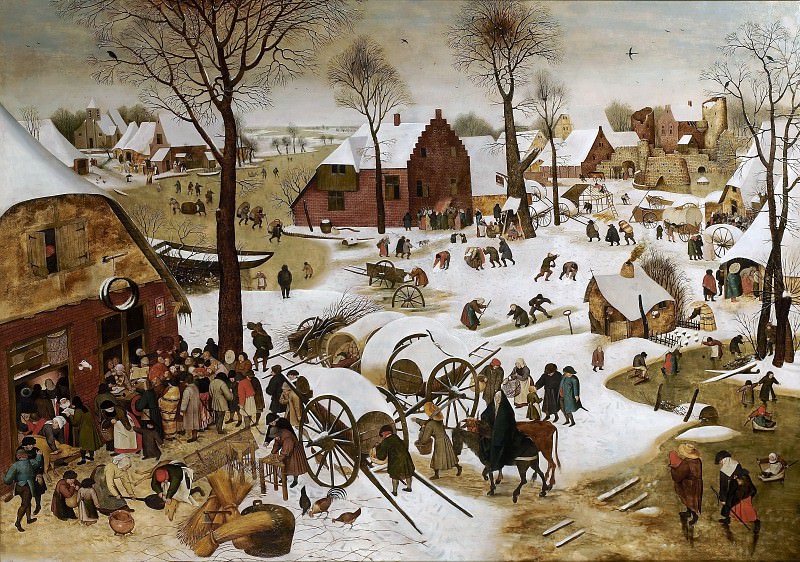The census in Bethlehem Pieter Brueghel the Younger (1564-1638)
Pieter Brueghel the Younger – The census in Bethlehem
Edit attribution
Download full size: 4096×2874 px (3,8 Mb)
Painter: Pieter Brueghel the Younger
Location: Museum Mayer van den Bergh, Antwerp (Kunstverzameling Mayer van den Bergh).
The well-known work, which has biblical content as its basis, was painted by Peter Bruegel back in the 16th century. The work shows the way of life of the people of the time, both domestic and social. Bruegel’s creative process seeks to show the authentic, the real essence of all that happens in the world. The Gospel versions disguise what is happening: for they convince us that Bethlehem is the true point on the globe where Jesus Christ came into being.
Description of Peter Brueghel’s painting "The Census at Bethlehem" (2nd version)
The well-known work, which has biblical content as its basis, was painted by Peter Bruegel back in the 16th century. The work shows the way of life of the people of the time, both domestic and social.
Bruegel’s creative process seeks to show the authentic, the real essence of all that happens in the world. The Gospel versions disguise what is happening: for they convince us that Bethlehem is the true point on the globe where Jesus Christ came into being. The prophets of the Old Testament say that this is the city where the messenger of higher powers appeared. But Joseph and Mary lived in Nazareth, this comes from a census conducted by Emperor Augustus, from which we can conclude that Mary gave birth to a child in Bethlehem.
In that era there were certain laws that obliged any visitor to go to the locality from which he came. Joseph sent his way to the city of David, even though it was dangerous and difficult. Since Mary was about to give birth to a child into the world, time was short and every second was at stake.
The author desperately tried to portray the essence of the lawlessness and ugliness that occurred because of the management of the authorities in the area. It shows the domestic arrangements of the people, but one detail makes the work seem religious--the donkey and the ox carrying Mary. These are the animals that are supposed to appear in The Nativity.
Perhaps without these details the work would have had some other motif.
Joseph is a secondary person, so it is impossible to see his face from the angle and with his headdress covered.
The author wants to draw attention to Christ’s presence here, in the present moment, in the crowd of people. What he is saying is that Jesus is invisible to us while he is outside of us and not inside.
Кому понравилось
Пожалуйста, подождите
На эту операцию может потребоваться несколько секунд.
Информация появится в новом окне,
если открытие новых окон не запрещено в настройках вашего браузера.
You need to login
Для работы с коллекциями – пожалуйста, войдите в аккаунт (open in new window).




















COMMENTS: 1 Ответы
влияние отца
You cannot comment Why?
The artist has meticulously rendered details that contribute to the overall atmosphere. The snow is not merely a backdrop but actively shapes the scene, creating drifts and obscuring pathways. Scattered across the foreground are overturned carts and broken wheels, suggesting a chaotic or hurried movement of people and goods. A flock of birds pecks at what appears to be spilled grain near the cart wreckage, adding another layer of detail and visual interest.
Beyond the immediate activity around the central building, smaller groups populate the landscape. Some individuals appear to be assisting with the census, while others are engaged in everyday tasks such as tending to animals or transporting goods. The placement of these figures creates a sense of depth and extends the viewers gaze into the distance. The buildings themselves, rendered with careful attention to architectural detail, contribute to the impression of a bustling rural community.
Subtleties within the scene hint at deeper meanings. The overturned carts could symbolize disruption or upheaval, perhaps alluding to the unexpected nature of the census itself and its impact on the lives of those affected. The crowded conditions suggest a sense of constraint or obligation. The presence of animals – birds, horses, and other livestock – grounds the narrative in a tangible reality while also introducing symbolic elements often associated with humility and pastoral life.
Overall, the painting conveys a complex interplay between order and chaos, community and individual experience, all set against the backdrop of a harsh winter landscape. The artist’s meticulous attention to detail and nuanced portrayal of human activity elevate this depiction beyond a simple record of an event; it becomes a meditation on the complexities of human life within a structured social context.